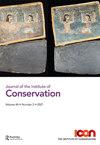迈向开放的保存文献服务
IF 1
0 HUMANITIES, MULTIDISCIPLINARY
引用次数: 2
摘要
摘要本文提出了一个允许使用链接数据技术共享保护数据的系统的实现。它首先审查了默认情况下应共享保护数据的原因,并强调了共享对实际任务的价值,如根据条件调查和环境监测记录评估环境控制。这篇文章还提出了由公共资金完成的工作的公共交付的论点,并通过研究共享数据在其他研究领域的价值来继续。它提到了只有共享数据才能实现的重要项目,如人类基因组计划和气象和生物多样性领域的其他项目。“五星链接数据”的简短介绍,以及链接数据的关键概念的描述,如统一资源标识符(URI)的生成和维护。给出了使保护数据可共享的拟议工作概述,其中包括术语协调、记录协调以及将本地数据库映射到全球模式(CIDOC-CRM)。文章最后试图确定社区维护数据共享系统的持续成本,并提到了保护专业机构的标准订阅模式以及它们之间协同作用的要求。本文章由计算机程序翻译,如有差异,请以英文原文为准。
Towards an open conservation documentation service
Abstract This article proposes the implementation of a system which allows for sharing conservation data using Linked Data technologies. It begins with a review of the reasons why conservation data should be shared by default and highlights the value of sharing for practical tasks such as assessing environmental control based on condition surveys and environmental monitoring records. The article also makes the argument for public delivery of work which is completed with public funding and continues by examining the value of sharing data in other fields of research. It makes reference to important projects which were only possible because of sharing data, such as the Human Genome Project (HGP) and other projects in the fields of meteorology and biodiversity. A short introduction to ‘5 Star Linked Data’ is included alongside a description of key concepts for Linked Data, such as the production and maintenance of Uniform Resource Identifiers (URIs). An outline of the proposed work for making conservation data sharable is given which includes terminology harmonisation, reconciliation of records and mapping of local databases to a global schema (CIDOC-CRM). The article concludes with an attempt to identify ongoing costs for the community to maintain a data sharing system and refers to standard subscription models of conservation professional bodies and the requirement for synergy across them.
求助全文
通过发布文献求助,成功后即可免费获取论文全文。
去求助
来源期刊

Journal of the Institute of Conservation
HUMANITIES, MULTIDISCIPLINARY-
CiteScore
1.50
自引率
0.00%
发文量
22
期刊介绍:
The Journal of the Institute of Conservation is the peer reviewed publication of the Institute of Conservation (Icon). As such, its aims reflect those of Icon, to advance knowledge and education in conservation and achieve the long term preservation and conservation of moveable and immoveable cultural heritage. The Journal provides a collective identity for conservators; it promotes and supports both the profession and professionalism. With international contributions on all aspects of conservation, it is an invaluable resource for the heritage sector. The specific aims of the Journal are to: 1. promote research, knowledge and understanding of cultural heritage conservation through its history, practice and theory 2. provide an international forum to enable and disseminate advances in research, knowledge and understanding relating to conservation and heritage 3. champion and support professional standards of heritage conservation in the UK and internationally 4. provide a permanent record of issues relating to conservation and heritage 5. be financially and operationally sustainable. To achieve these aims, the Journal invites contributions from all those involved in the conservation of cultural heritage and related activities. Areas of interest include understanding cultural heritage materials and their degradation; subject reviews and histories of cultural heritage materials and conservation treatments; new, innovative or improved approaches to conservation and collections care theory, practice, communication, management and training; case studies demonstrating new, innovative or improved approaches; and conservation in its wider context. Submitters are encouraged to demonstrate how their work is of practical application to conservation. To maintain professional standards and promote academic rigour, submissions of articles and shorter notices are subject to an anonymous peer review process.
 求助内容:
求助内容: 应助结果提醒方式:
应助结果提醒方式:


